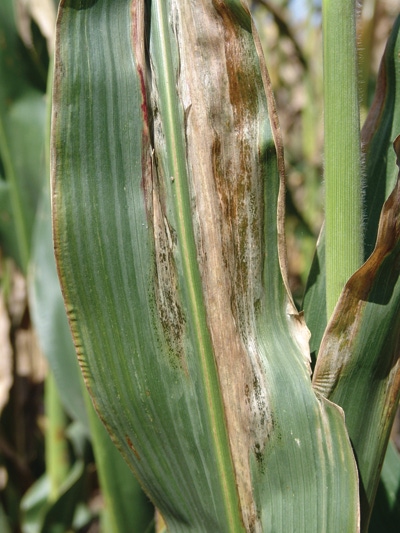August 9, 2011

Goss' leaf blight and wilt of corn is a damaging disease that is new to Minnesota and has caused problems in fields over the past two years. The weather conditions this summer may favor development of this disease again. It was reported from two fields in southern Minnesota in the past week, and it may start to develop in many fields. This is a disease to watch for across Minnesota; if you see infected plants, please send infected leaf samples for a new research study as described on the next page.
Although Goss' bacterial leaf blight and wilt of corn was first found in Nebraska in 1969, it was not confirmed in Minnesota until 2009, when it was found in fields near Morris and Hastings. In 2010 this disease developed in many fields across southern Minnesota. This can be a significant disease problem, with yield losses reported as high as 70-80 bu./acre in Minnesota.
The symptoms on plants infected with Goss' leaf blight and wilt are typically seen on the leaves, although they can include stalk infection. Tan linear lesions with irregular margins extending parallel to the veins develop on leaves, and these can affect 50% or more of the leaf area. Irregular dark water-soaked spots ("freckles) develop in the lesions. Shiny patches of dried bacterial ooze (appears like a thin layer of dried egg white) is often present on the lesions. For plants with systemic stalk infection, the stalk can have orange vascular bundles. Symptoms in Minnesota over the past two years have been noted primarily in early to late August.
Goss's leaf blight and wilt is caused by a bacterial pathogen that overwinters in infested corn debris near the soil surface. It primarily infects through wounds caused by hail, wind, rain, wind-blown sand or possibly machinery. Development of this disease is favored by warm, wet and humid conditions.
Goss' leaf blight and wilt can be managed by using resistant hybrids, rotating crops, deep tilling after harvest and by controlling grassy weeds. Grasses such as green foxtail, shattercane and barnyard grass can be infected by the Goss' wilt pathogen. Fungicideapplications do not provide any control for this disease.
Research project
A new research project was recently started at the University of Minnesota to study traits of the bacterial pathogen that causes Goss' leaf blight and wilt. For this study, we need samples of infected leaves from as many locations in Minnesota as possible.
The process for collecting and sending samples is simple. Please pick 3 leaves with lesions, remove most parts of the leaves that do not have brown lesions, wrap them in wax paper or two layers of heavy brown paper (as from paper bags), place them in a paper or cardboard envelope and send via mail or FedEx (2-day delivery is be fine). Please mail so they don't arrive on a weekend, as they cannot be delivered then. Send samples to Dean Malvick, Department of Plant Pathology, 1991 Upper Buford Circle, 495 Borlaug Hall, University of Minnesota, St. Paul, MN 55108. Questions can be sent to Dean Malvick via email at [email protected].
You May Also Like




